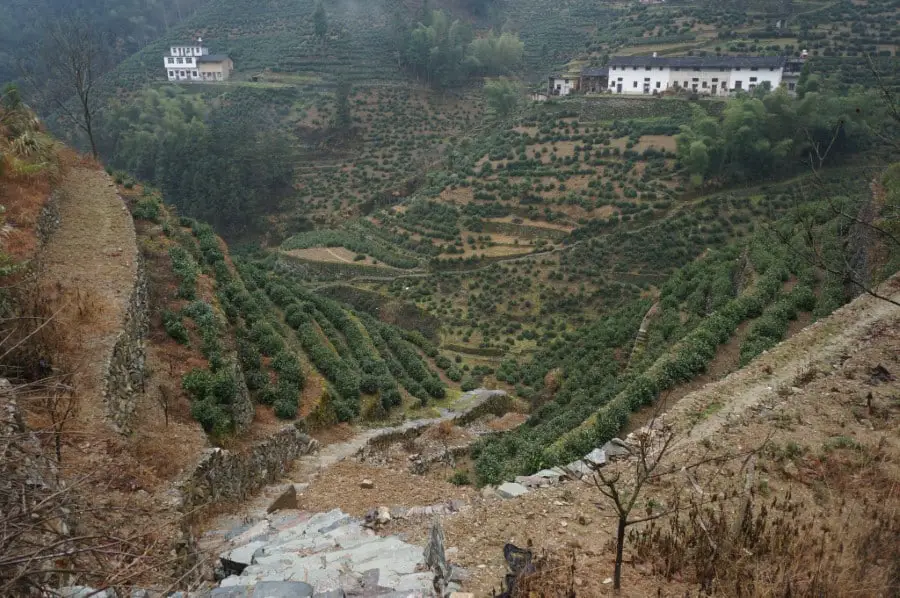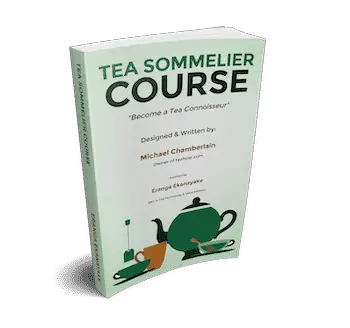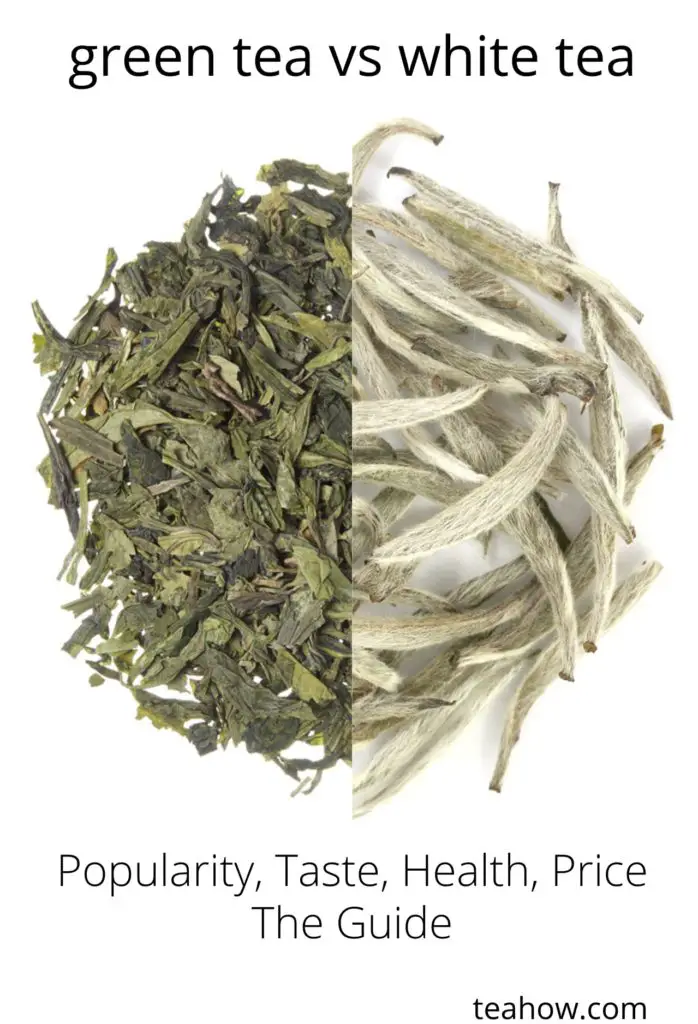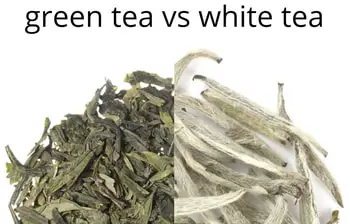With so many tea varieties around, it’s sometimes hard to discern the differences, or what advantages one might have over another. That’s when we start to research comparisons that can help us put this in perspective.
So in this article, we’re focussing on green tea vs white tea, or even white tea vs green tea. Depending on which angle you’re coming from.
But first, here’s a quick answer, then we’ll dive into more details…
Green Tea vs White Tea? Green and white teas are true teas derived from the Camellia Sinensis plant. Green tea is produced in many countries, but white tea is mostly from China. White has less processing than green. Both are described as light, vegetal, and sweet. White tea is considered healthier but can be more expensive
There’s the quick roundup answer, but there are more details to understand about these two teas. So let’s dive into some details…
Green tea vs white tea – quick comparison table
Here’s a quick overview to offer some basic comparisons between green tea and white tea.
| White Tea | Green Tea | |
|---|---|---|
| Derived From | Camellia Sinensis | Camellia Sinensis |
| Plantation Regions | Mostly in China | Most tea growing countries |
| Harvest Season | Spring and early Summer | Most harvested in the Fall |
| Processing | Less processed | More processed than white |
| Popularity | Low | High |
| Availability | Scarce | Plentiful |
| Taste | Light, vegetal, sweet | Light, vegetal, sweet |
| Caffeine (p/8oz) | 15 to 30 mg | 30 and 50 mg |
| Catechins (mg p/gram) | 14.4 to 369.6 | 21.38 to 228.2 |
| Health Benefits | Very High | High |
| Price | High | Medium |
Green tea vs white tea – what they are made from
Both white and green tea are produced from the same plant, the Camellia Sinesis, commonly referred to as the “tea plant”. The tea plant has been cultivated for thousands of years for producing tea, you can read more facts about tea in my 100 Facts About Tea article.
So really, the ultimate difference between these two tea types comes from what point they’re harvested, from which part of the tea plant, how they are processed after harvesting, and so on.
Green tea vs white tea – Where and when they are grown
Fujian province of China is the most popular place where white tea is grown.
These teas are harvested mostly in spring and early summer. In general, most white teas are harvested at the latter end of May.
Green tea on the other hand is grown in many of the 62 popular tea-growing countries.
Some of these popular countries include:
- China
- Japan
- India
- Sri Lanka
- Taiwan
- Bangladesh
- New Zealand
- Hawaii
- South Carolina
Green tea, however, is believed to have originated in China.
Green teas are harvested mostly in early Spring and in the Fall. Some believe that the high-quality first flush of green teas is produced in early spring when the plant has had all Winter to absorb nutrients and minerals from the ground.

Green tea vs white tea – Processing
When comparing the similarity of processing techniques of these two teas, both are certainly less processed than other types such as black, dark, or oolong tea.
This is one of the reasons why both these teas are said to be “light” when brewed correctly.
White is less processed than green tea. As soon as white tea is harvested they are withered outdoors.
Then, the now withered white tea leaves go through an indoor drying and sorting process. In other words, they are left out to dry naturally.
Green tea is more processed than white tea. Once harvested, green teas are withered just like white teas. Then, these tea leaves are put through a process to stop oxidation (usually they are either steamed or fried) after which they are rolled, dried, and sorted.
It’s also important to mention that unlike white tea, not all green teas are withered, and some green teas may skip the withering process altogether.
The popularity of green tea vs white tea
When it comes to popularity, it’s the green tea that takes the lead. For one thing, the processing of green tea is much easier than that of white tea.
For example, an excellent quality white tea will have a lot of silvery haired buds, which most of us may not have come across.
If your white tea doesn’t have any of these fine silver hairs at all, then it’s most likely to be made from older, more mature leaves.
And if you purchase white teas in tea bags, it’s very likely to be a lower quality – the same as most tea bags.
This is because the processing of white tea is much more complex and fragile than green teas that they can’t be compressed into dust or smaller particles more readily.
This is also why you are less likely to have come across a good quality white tea and more likely to encounter low-quality white tea than low-quality green tea.
This complexity of fragile processing for white tea is one of the main reasons why white tea is less in circulation and therefore isn’t as commonplace – or as popular as green tea.
That leads nicely on to availability…
Availability of green tea vs white tea
The popularity of white tea has something to do with white tea again, white tea is not as available as green tea for a number of reasons.
Firstly, white tea takes complex cultivation and processing, so it’s hard to master easily.
Secondly not all tea producing countries make white tea, because it calls for precise cultivation and harvesting techniques – it’s just easier to make black and green teas.
Thirdly, white tea calls for careful brewing to offer up its unique taste, which is hard to master by many tea consumers, let alone tea sommeliers.
This makes it less in demand when compared to green tea. Consumers mostly look for easy ways to enjoy tea.
Because of this, the availability of white teas and different types of white teas are narrowed down to a few countries only.
By contrast, green tea is available with a wide variety of choices and types, from different countries from all over the world. A classic case of consumers ultimately driving demand.
Taste profile of green tea vs white tea
The taste profile of both these teas can vary depending on where they’re grown, harvested, and processed.
However, in general, both teas produce a light flavor profile with naturally sweet, nutty, bitter, fresh, and vegetal tones.
Green tea more specifically has been described as having a bittersweet, nutty, floral, buttery, fruity, swampy, oceanic, toasty, and smoky flavor.
These flavor tones make green tea stronger than white tea. They’re generally sweet, but steamed green teas often yield a more bittersweet after taste.
White tea on the other hand has light, sweet, spicy, hay, and fresh flavor tones.
Because this tea is lighter, many tend to blend in fruity and floral flavors for a more palatable taste.
So in some types of white tea, you can even find fruity or floral ingredients like lavender, grape, honeydew, and apricot.
White tea is, however, largely considered sweeter and lighter than green tea – with a more delicate flavor profile, because the leaves for white tea are harvested at a younger stage in their growth.
However, for you to get these exact flavors from these teas, you ideally need to drink them without milk, that applies to both green and white tea.
Brewing – green tea vs white tea
You can brew both these teas using either western or eastern brewing techniques. For green tea, you could refer to my article on How to make green tea.
Below is a breakdown using both these techniques.
Western brewing techniques
What you’ll need:
- Hot water with a temperature of 167°F-185°F
- Teaspoon
- Strainer or infuser
- Tea leaves or tea bags as you desire – more the stronger you like it (The standard recipe calls for one green/white tea bag or one tablespoon of green/white tea leaves)
- Sugar or any sweetener you desire (An authentic green/white tea has no sugar)
Pour one cup of hot water and add tea bags or tea leaves of your choice.
Steep it for 2-3 minutes, you can steep them for longer if you wish, but it may not give the exact taste that we have discussed.
Once steeped, strain if you used tea leaves or dispose of the tea bag, add sugar or any sweetener if you want, serve and enjoy.
Eastern brewing technique
What you’ll need :
- Hot water at a temperature of 194°F for white tea and lower for green tea
- Strainer or infuser
- A higher amount of green/white tea leaves (For eastern brewing technique, you use a higher amount of tea leaves and re-steep them multiple times)
- Sugar or any other sweetener you desire (Authentic brewing doesn’t include adding sugar)
You have to follow the same methods as for western brewing but with the tea leaves instead.
The water to the tea leaves ratio, depends on how strong you want the tea.
Usually, it’s recommended to fill your brewing vessel with 1/3 of tea leaves and the rest with water.
For the first infusion of white and green tea, steep for 20-30 seconds and 45-60 seconds respectively. Extend this by 5-10 seconds extra for each subsequent steeping.
This style of brewing allows you to taste both white and green tea in “sections” of the full flavor spectrum.
If you’re the kind of person who likes steeping green tea or white tea, then you’ll love my Tea Sommelier Course…

Take the fast track and become a tea connoisseur
Whether for enjoyment or considering a career as a tea sommelier. This course has everything you need to enhance your tea knowledge and tea-tasting skills.
This course keeps it simple with step-by-step tea tasting and easy reference guides
For pleasure, or as a precursor to a career in the tea industry. Find out what tea sommelier actually does, their career paths, and what they earn.

Find out more about the Teahow Tea Sommelier Course!
Find out more about the Teahow Tea Sommelier Course!
I’ve talked at length about Caffeine in green Tea, but let’s quickly look at the Caffeine comparisons between green and white Tea…
Caffeine content green tea vs white tea
When it comes to the caffeine content of these teas, white tea on average has higher caffeine than green tea. In fact, white tea may even contain more caffeine than black tea.
This is because teas that have younger leaves will usually have more caffeine than those with older and bigger leaves.
A study agreed with this, by saying that the average amount of caffeine for white teas is 28.584 mg per 100 ml, whereas for green tea it is 26.445mg per 100 ml.
Read more about this in my article Does Green Tea Have Caffeine
Catechins in white and green tea
White teas contain wider samples of catechins than green tea.
According to a study white tea has catechin content ranging from 14.40 to 369.60 mg per gram of dry leaf, whereas green tea has catechin content ranging from 21.38 to 228.20 mg per gram of green tea dry leaf.
The report stated that “Certain white teas have comparable quantities of total catechins to some green teas, but lesser antioxidant capacity, suggesting that white teas have fewer non-catechin antioxidants present”
Catechins are responsible for many benefits from fighting free radicals to promoting cardiovascular health and helping with fat burns.
However, it doesn’t mean that the most expensive high-quality tea will have more catechin and vice versa.
Also, this catechin content may vary depending on how each of these tea types is cultivated, harvested, and processed.

Which is healthier – green tea vs white tea
Both white and green tea have similar health benefits and side effects because they both originate from the same plant.
This also means that both these teas have the same powerful combination of antioxidants, trace minerals, and nutrients.
If you’re taking either of these teas for the health benefit of weight loss, then green tea provides the greater benefits.
White tea is popularly known as a beauty tea, unlike green tea that’s famous for weight loss.
However, white tea can also help with weight loss and green tea can also help with maintaining skin.
Aside from this, both teas also share similar side effects. Side effects are not anything like severe …as long as the amount you consume of either tea is in moderation.
However, both green and white tea contain caffeine and so should be avoided by those who are sensitive to caffeine – based on their own personal tolerances.
Both these teas are “raw” types of tea, and can potentially upset the stomach, so you should avoid drinking these on an empty stomach.
However, with all these similarities, white tea still takes a slight edge when it comes to being healthier over green tea. For more on this check out my article on white tea.
Price For green tea vs white tea
Both green and white tea tea can actually command the cheapest and the most expensive price.
It’s never really possible to give a standard price. This is because the price of any tea varies with the climatic conditions and related success with a harvest.
However, both high-quality green and white tea from popular tea growing places like China and India are high comparatively.
Also on average white and green tea are more expensive than classic black tea and higher end version can be pretty expensive!
To finish
For me, white tea perhaps requires a little more patients and know-how when it comes to infusing and drinking, but the results are worth the wait – and the bit extra on price.
If you’re the kind of person who inquires about green and white teas, then you may be interested in upping your tea game with my fabulous Tea Sommelier Course.

Take the fast track and become a tea connoisseur
Whether for enjoyment or considering a career as a tea sommelier. This course has everything you need to enhance your tea knowledge and tea-tasting skills.
This course keeps it simple with step-by-step tea tasting and easy reference guides
For pleasure, or as a precursor to a career in the tea industry. Find out what tea sommelier actually does, their career paths, and what they earn.

Find out more about the Teahow Tea Sommelier Course!
Find out more about the Teahow Tea Sommelier Course!

